COOPERATION MODEL
ARTIFICIAL INTELLIGENCE
PRODUCT ENGINEERING
DevOps & Cloud
LOW-CODE/NO-CODE DEVELOPMENT
FRONTEND DEVELOPMENT
CLOUD DEVELOPMENT
MOBILE APP DEVELOPMENT
LOW CODE/ NO CODE DEVELOPMENT
EMERGING TECHNOLOGIES







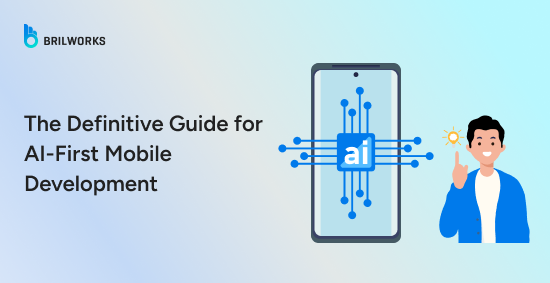
In 2025, the global app market is valued at nearly $300 billion, and by 2029 it is expected to cross $700 billion, as per Statista’s report on mobile app market growth.
The numbers show growth, but what matters more is how this growth will play out. The way apps are built is changing, heavily influenced by artificial intelligence. According to Google's 2025 DORA report, 90% of software professionals now use AI into their daily tasks, a 14% increase from the previous year.
AI is being plugged across entire product development lifecycle, from ideation and testing to feedback loops and release cycles.
McKinsey’s “State of AI 2025” survey highlights that 21% of companies already say they’ve redesigned workflows to plug AI into their development ecosystem, and that AI Mobile app development companies placing governance and accountability (like CEO oversight) over AI see stronger bottom-line impact.
Well, we have already written a lot about mobile app development trends, here is a brief of what a mobile app development company should be aware of in order to build the features that are in demand.
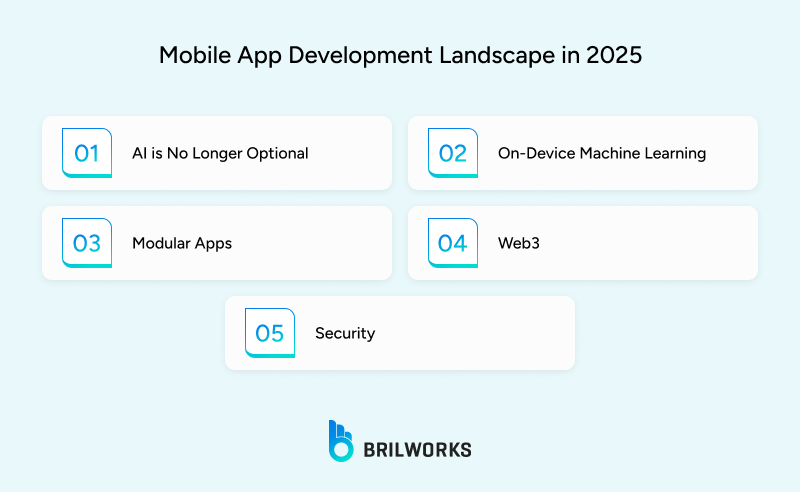
In 2025, artificial intelligence becomes the core of application experiences. Applications must now adapt, and utilize learning. AI as a tool can do so much more than automate - it can personalize content types and it can predict user behaviours.
If an application does not include AI into business operations, then you are already behind. It is all about the predictive experience, on-going data processing, and reactivity. If you are still thinking about AI as something you can bolt on at the end, then you are already missing the boat.
Cloud computing is becoming obsolete. With powerful chips, mobile applications are performing more and more functions locally. That's why, it's becoming much easier for innovative companies in fintech and health-tech to reduce their dependency on cloud computing.
The concept of putting everything in one app is not popular anymore. Super apps are on the decline, while modular apps are becoming popular. Users want their apps to be flexible to turn features on or off as required.
Web3 is transforming identity, payments, and data-management capabilities in apps. Technologies like decentralized identities give users broader control over their data. Technologies like stablecoins are enabling faster, lower-cost payments.
If you're not thinking about how Web3 can enable better efficiencies in the infrastructure of your apps, you're likely going to fall behind rather than leaning into the opportunities.
Addressing security vulnerabilities as you go is an old-school practice? Security considerations are now introduced at the very beginning. Applications must be secure by design instead of a follow-on activity. Through DevSecOps and AI-based security monitoring, applications are in continuous monitoring mode for vulnerabilities.
AI is increasingly adopted, with 78% of organizations using it in at least one function in 2024, and 71% using generative AI.
97% of companies deploying AI technologies have reported benefits.
The financial impact of AI is being realized by 46% of companies, an increase from 33% a year prior.
AI is a top priority for 83% of companies, with 92% planning to increase their AI investment in the next three years.
McKinsey estimates AI could lead to a $4.4 trillion productivity boost.
Despite adoption, over 80% of companies using AI haven't seen significant productivity or ROI improvements.
Data integration into AI models is a challenge for 70% of top-performing companies.
Distrust in AI code assistants is high among developers, with 66.1% reporting it.
64.6% of developers find AI tools lack codebase context.
Only 1% of leaders consider their organizations "AI mature".
The global AI market was valued at $391 billion in 2024 and is projected to exceed $1.8 trillion by 2030, growing at roughly 37% CAGR.
The global mobile artificial intelligence market was valued at $19.5 billion in 2024.
This mobile AI market is expected to grow at an average annual rate of 25.1% between 2025 and 2034.
A significant barrier to AI adoption is the lack of skilled professionals, cited by 50% of businesses worldwide in 2025.
Over 65% of employers in IT and telecommunications anticipate AI and big data to be essential skills for their workforce between 2025 and 2030.
While nearly eight in ten companies have deployed generative AI, a similar percentage report no material impact on earnings.
According to analysts and industry experts:
AI will not be used an extra feature, instead apps will be built using AI as their core foundation from the ground up.
Personalization is where the AI will have most impact. AI will improve personalization by reading and analysing real-time user events, and provide recommendations on the fly.
AI will automate large portions of the development process. Gartner predicts AI will automate 60% of app design by 2026. However, it is highly unlikely that AI will take a pilot seat, at least in a coming few years.
Natural language processing have already been implemented largely. It makes voice-enabled interfaces more accurate and conversational.
Mobile apps will increasingly use edge computing to process AI models on the user's device rather than in the cloud.
Gartner predicts that up to 40% of enterprise applications will feature task-specific AI agents by 2026, up from less than 5% in 2025. These autonomous agents will perform complex, end-to-end tasks without direct human intervention.
Companies are activaly leveraging AI systems to detect anomalies and unusual activity.
AI will power more powerful low-code and no-code platforms, allowing more non-technical users to build and deploy functional apps.
In order to shift into an AI-led development model, AI-led mobile app development companies must view AI as more than just a feature added to the final product. If you are simply building a development workflow where AI can be plugged in and utilized across the entire development lifecycle, you are creating true AI integration.
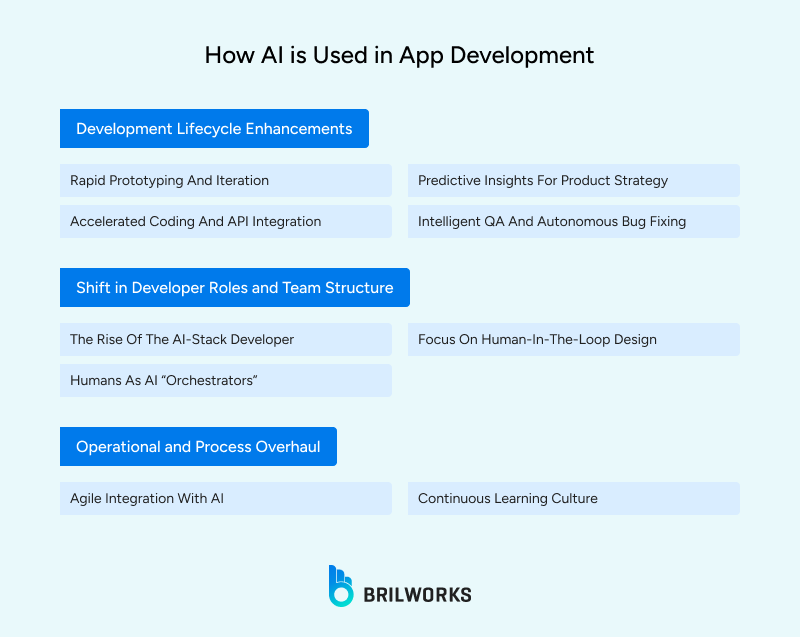
Below are some areas where AI is being used by small to medium-sized businesses.
1.1. Rapid prototyping and iteration
Rather than taking weeks to do manual wireframing and prototyping, you can rely on AI-powered software to generate fully functional app screens.
For example, an AI can automatically generate the required User Interface components and integrations for a new feature based on a developer's description of the user journey.
1.2. Accelerated coding and API integration
AI tools, such as the ones available in Visual Studio IntelliCode, suggest and autocomplete code, help reduce redundant tasks and human error. Additionally, AI agents are emerging to automate more complicated tasks, including writing API integrations for third-party services, allowing developers to focus on higher-value and more creative work.
1.3. Predictive insights for product strategy
Agencies could use AI to take market research to the next level. They can use it to assess real-time customer feedback, social media engagement, or competitive data, leading to more actionable insights.
This will allow product managers to make more data-driven decisions about feature prioritization and product roadmaps, limiting their chances of failure.
1.4. Intelligent QA and autonomous bug fixing
Traditional quality assurance (QA) can be labor-intensive, and AI-based QA can replicate tens of thousands of real-world usage scenarios infinitely faster, maybe more effectively than a human.
Some AI systems can even automatically rewrite code to fix identified bugs and performance concerns without human assistance.
2.1. The rise of the "AI-stack developer
The responsibilities of mobile developers are shifting away from platform-centric coding. Agencies will need individuals who are more knowledgeable about working with AI and architecting "AI-native" systems.
This will require knowledge of data science and machine learning and will mean that front-end developers will need to shift towards a more full-stack, end-to-end innovation role.
2.2. Humans become AI "orchestrators
The role of the developer moves from direct, manual building to an orchestration role that is a level above the actual manual development. They are skilled at building the high-level goals from which the AI agents build the software for most of the development work. T
his requires strong problem-solving skills and reasoned thought, where human creativity and judgment are still necessary.
2.3. Focus on 'human-in-the-loop' design
As AI automation continues to grow, the responsibility of UX researchers is even more amplified. Their specialization in "human-in-the-loop" design ensures that AI-generated features serve human needs and align with human values thereby avoiding issues of algorithmic bias.
3.1. Agile integration with AI
Agencies are integrating agile methodologies with AI-enabled processes. This allows them to iterate more quickly and react to shifting market dynamics as they occur. For example, AI tools can identify a potential delay in a sprint and make a suggestion for potential action in advance, enabling the project to stay on-schedule.
3.2. Continuous learning culture
With AI evolving at a rapid pace, agencies are going to have to start nurturing a culture of ongoing learning. Developers and product managers will need ongoing education and training around the latest tools and best practices. If agencies are not investing in this upskilling, they risk getting left behind.
Below are some notable examples of AI-powered applications that are changing the ways we work and create.
Jasper: AI writing assistant for B2B marketers and content creators to generate marketing copy, blog posts, product descriptions, and social media captions.
Copy.ai: Generates a variety of content for marketing needs and integrates with other marketing software.
Writesonic: An all-in-one content optimization platform with an AI-powered article writer for creating SEO-friendly articles, marketing copy, and landing pages.
Frase: Specializes in content research and optimization by analyzing search intent and suggesting keywords.
Salesforce Sales Cloud/Einstein: An AI-powered CRM that helps sales teams with lead qualification, forecasting, and automating tasks.
Cognism: A sales intelligence platform providing B2B lead data, including verified contact information, with features like an AI search function.
Overloop AI: A sales automation platform that generates multi-channel outreach campaigns and ultra-personalized emails at scale.
Apollo.io: Supports prospecting, outreach, and engagement processes, with AI features for lead scoring, email writing, and conversation analysis.
Gong: A revenue intelligence platform that uses AI to analyze customer interactions across multiple channels and identify actionable sales insights.
Botsonic: An AI chatbot builder that creates custom, multilingual chatbots to automate customer support and assist with queries.
Fireflies.ai: Automatically transcribes, summarizes, and takes notes on meetings from platforms like Zoom and Google Meet.
RingSense: Analyzes communication data from calls and emails to provide conversation analytics, offering insights on customer satisfaction and sentiment.
Krisp: Uses AI to remove background noise, echo, and voice overlap from online meetings, and can also generate call summaries.
ThoughtSpot: An AI analytics platform that enables self-service analytics, allowing users to ask natural language questions to receive instant insights and visualizations.
Microsoft Power BI with AI Insights: A business intelligence tool with integrated AI capabilities, offering automated pattern recognition and natural language Q&A for datasets.
Google Cloud AI Platform: A comprehensive suite of AI and machine learning tools, including AutoML, for building custom models and integrating pre-built APIs.
Notion AI: An AI assistant integrated into Notion's workspace for summarizing, brainstorming, organizing, and drafting content.
Asana: A project management tool that uses AI for task automation, intelligent workflow suggestions, and smart deadline predictions.
Zapier: An automation tool that uses AI to connect different apps and automate workflows across a business's tech stack.
Motion: An AI-powered scheduling app that automates task management and meeting scheduling based on workload and deadlines.
Ahrefs: An SEO toolset with AI features for website audits, keyword research, and competitive analysis.
Surfer SEO: Analyzes top-ranking pages for a keyword and provides suggestions to optimize content for better search engine rankings.
Hootsuite: A social media management platform that uses AI for content creation, strategic recommendations, and social listening.
Mailchimp: An email marketing platform with an AI assistant to help create on-brand email campaigns and analyze audience segments.
The implementation of AI in applications, while exciting opportunity, has its own set of challenges that might affect an app's stability, user confidence, and effectiveness overall.
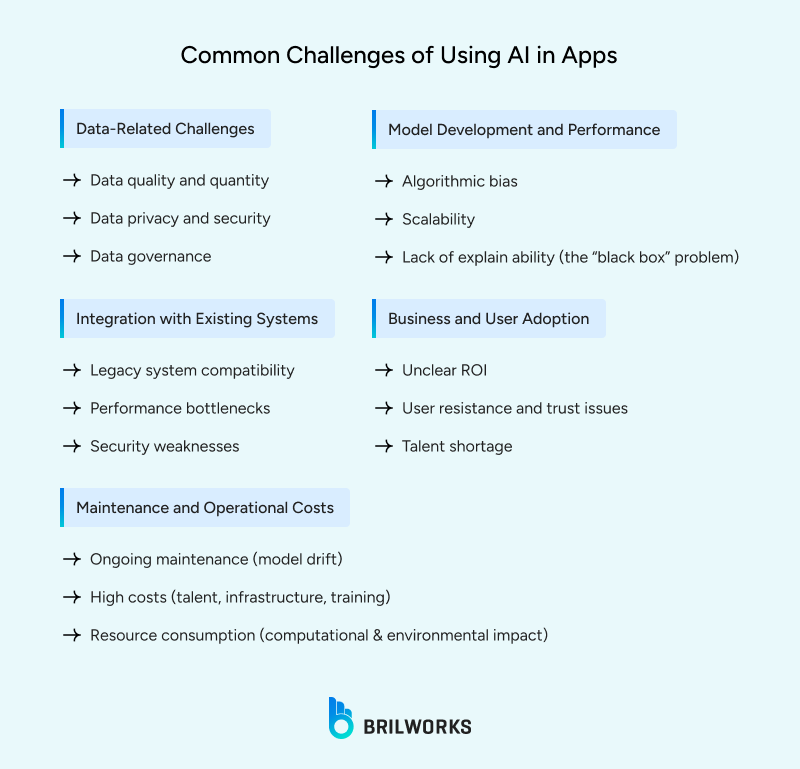
These models performance heavily depends on the data it's built upon. This section outlines some data related challenges in AI development that can impact AI systems.
1. 1. Data quality and quantity
AI models work well only if they are trained on good data. If the data used to train AI models is poor quality, incomplete, or mis-labeled, the outputs they produce will not be accurate or reliable. For specialized industries (i.e. health care) where data is limited, lack of data can also be a significant barrier.
1.2. Data privacy and security
Artificial intelligence systems frequently depend on large amounts of data, often incorporating any sensitive information from users. Developers are required to overcome challenges and implement security measures, as well as comply with evolving data privacy regulations like GDPR. This can pose challenges related to the large sets of data.
1.3. Data governance
When data is combined from multiple sources, you may encounter inconsistencies, duplicates, and access controls. If there is no clear governance plan that outlines security measures and supervision, the reliability of the AI model can be challenged.
Creating high-performing AI systems requires thoughtful design, tuning, and monitoring to ensure models behave as intended.
2.1. Algorithmic bias
AI systems can inadvertently perpetuate or amplify societal biases that exist in their training data. This can lead to discriminatory outcomes in sensitive areas like hiring or facial recognition and requires continuous monitoring and auditing to correct.
2.2. Scalability
As an app's user base and data volume grow, the AI system must be able to scale without performance degradation. This requires substantial computational power, and managing AI models in hybrid or multi-cloud environments can introduce complexity and latency.
2.3. Lack of explainability
(the "black box" problem): Some AI models, particularly complex ones, can be difficult to interpret, making it hard to understand how they arrive at a particular conclusion. This lack of transparency can erode user trust, especially in high-stakes industries like finance and healthcare.
2.3. Integration with existing systems
For apps that are not built from scratch, integrating AI with existing legacy systems can be complex, time-consuming, and require significant architectural modifications. Compatibility issues, performance bottlenecks, and security weaknesses are common.
Beyond initial development, AI systems require ongoing resources to remain effective, secure, and aligned with evolving needs.
3.1. Ongoing maintenance
AI models are not "deploy and forget." They require continuous monitoring and retraining to adapt to new data, user behavior, and market conditions. Ignoring this can lead to performance degradation, a phenomenon known as "model drift".
3.2. High costs
Developing an AI-powered app often involves substantial initial and ongoing costs. These include expensive talent, advanced infrastructure (like cloud services), and the significant resources required for data preparation and model training.
3.3. Resource consumption
Training large, complex AI models consumes vast amounts of energy and can be computationally intensive, which can increase operational costs and raise environmental concerns.
Successfully integrating AI into business operations depends not only on technology but also on how well users embrace and trust these systems.
4.1 Unclear ROI
Proving the financial value of an AI project can be difficult, making it challenging to secure stakeholder buy-in. Measuring AI's benefits can be complex, especially when they aren't tied to immediate cost reduction.
4.2. User resistance
User trust is a critical challenge. Some people are wary of AI-driven features, fearing a loss of control or misuse of their data. Inadequate communication about how AI works can lead to low adoption, even for a well-designed feature.
4.3. Talent shortage
There is a high demand for AI and machine learning experts, which can make it difficult and expensive for companies to build and retain a skilled development team.
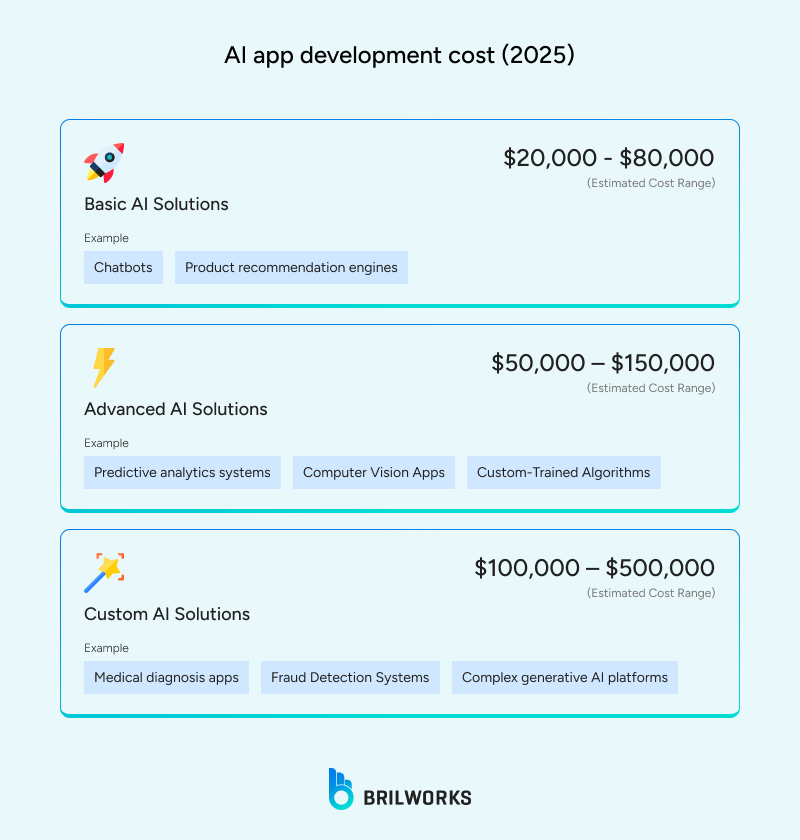
The cost to develop an AI-powered app can range from $25,000 for a basic solution to over $500,000 for a complex, enterprise-level system, with custom generative AI apps potentially exceeding $1 million. The final price depends on various factors related to complexity, data requirements, talent, and ongoing maintenance.
The level of sophistication and customization of the AI model is the most significant cost driver.
Basic AI solutions: Cost between $20,000 and $80,000 and typically use pre-trained models or APIs. Examples include simple chatbots for customer support or product recommendation engines based on user behavior.
Advanced AI solutions: Cost between $50,000 and $150,000 and require custom model training with more complex algorithms. This includes advanced computer vision apps or AI-driven systems for predictive analytics.
Custom AI solutions: Can cost upwards of $100,000 to over $500,000 and involve creating models from scratch for highly specialized tasks, such as medical diagnosis or complex financial fraud detection.
The quality, volume, and preparation of data can significantly impact the final cost.
Data collection and preparation: Acquiring, cleaning, and labeling datasets for training AI models is expensive and can account for 15% to 25% of the total project cost.
Specialized datasets: Accessing proprietary or industry-specific data, such as medical records or financial transactions, incurs higher costs than using publicly available information.
Data security and compliance: Protecting sensitive data and adhering to regulations like GDPR and HIPAA adds costs for implementation, audits, and ongoing governance.
The project's technology stack, talent, and cloud infrastructure are major components of the overall budget.
Development team: The size, expertise, and geographical location of your team greatly influence costs. Experienced AI engineers and data scientists command high salaries, with average hourly rates varying significantly by region.
Technology stack: Using advanced frameworks and cloud services for computing power increases costs. While open-source tools like TensorFlow can reduce expenses, powerful GPUs for training large models or licensing commercial platforms can be expensive.
Integration: Connecting the AI app with existing legacy systems, third-party APIs, or databases can be complex and costly, with expenses ranging from $20,000 to over $100,000 depending on the project.
The cost of an AI app doesn't end after launch. Ongoing maintenance is essential for long-term performance.
Cloud hosting fees: Usage-based pricing for cloud platforms like AWS, Azure, or GCP can fluctuate, with monthly costs for mid-sized apps ranging from $5,000 to $20,000.
Maintenance and updates: Regular monitoring, bug fixes, security patches, and model retraining to prevent "model drift" can represent 15% to 25% of the initial development cost per year.
Marketing and support: After deployment, marketing, user acquisition, and ongoing technical support add to the total cost of ownership.
See Also: The Hidden Costs of Outsourcing Mobile App Development [How to Reduce Them]
For businesses looking to navigate this complex AI landscape, partnering with an expert AI development company can make all the difference. We specializes in AI mobile app development services, guiding organizations. By combining technical expertise with strategic insight, we help you define a clear roadmap, mitigate risks, and deliver AI-powered solutions that drive measurable results.
Partner with us to leverage our experience as an AI mobile app development company and turn your innovative ideas into functional, market-ready solutions. Whether you want to hire AI mobile app developers or explore cost-effective strategies for your next project, we provide tailored services that align with your business goals.
AI can be applied to mobile apps for personalization, predictive analytics, automated workflows, chatbots, and intelligent user interfaces, helping deliver a smarter and more engaging experience.
Key challenges include data privacy concerns, integration complexity, model training and evaluation, latency issues, and aligning AI capabilities with user expectations.
Traditional app development focuses on static features, while AI-powered apps adapt, learn, and personalize experiences in real time, providing more value to users.
Integration involves selecting appropriate AI models or APIs, preparing datasets, defining user flows, implementing backend logic, and continuously testing and refining performance.
AI helps enhance app usability, automate processes, predict user needs, and reduce manual intervention, ultimately improving engagement and retention.
Yes, in some cases, AI assistants streamline tasks and automate actions, which can reduce the frequency of manual app interactions while improving user satisfaction.
Get In Touch
Contact us for your software development requirements
Get In Touch
Contact us for your software development requirements